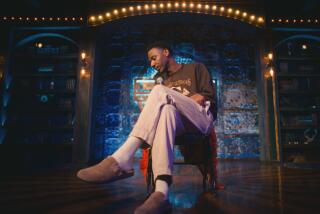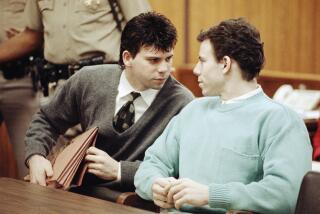In ‘True Story,’ a writer and a killer weave an ambiguous web

Nonfiction stories on screen, long a little traction-challenged, have become especially slippery of late.
Hit television reality franchises such as “The Bachelor” and “Real Housewives” can present basic human emotions as a form of sports. Sports figures are dressed up in elaborate narratives. The cable phenomenon “The Jinx,” a twisty tale of the alleged twisted acts of Robert Durst, presented itself as fact, even though, like many documentaries, it was rife with elisions and edits.
What to make, then, of “True Story,” about the dance between disgraced journalist Michael Finkel and the convicted killer Christian Longo? The true-crime movie — starring James Franco as the murderer and Jonah Hill as the journalist — is dramatized from Finkel’s nonfiction book on the subject, which in turn is about both the author’s confessed lies and a killer’s compulsive deceit. Its title suggests bedrock honesty. But the film that follows wonders whether such a claim is ever possible.
“I’ll admit,” said its director, the theater veteran Rupert Goold, “that part of making ‘True Story’ was figuring out what a true story is.”
Opening in theaters April 17, barely a month after Durst’s apparent on-screen confession, “True Story” is a murder-mystery told in the manner of “The Jinx” but also as interested in the telling as in the mystery. It’s a procedural that doesn’t just ask audiences to interpret events but also implicitly ponders the validity of interpretation in the first place.
In 2002, Finkel, then 33, was flying high as a conflict-zone writer for the New York Times Magazine when he was caught inventing a composite character for a cover story about childhood poverty in Africa. After he’d returned from an assignment in Mali and the Ivory Coast, an editor asked if he could write a deep-dive portrait of a single poor child. Instead of simply saying he didn’t have the goods, Finkel told her he could, then blended details from multiple children and presented them as one. He rationalizing that the spirit of the story, at least, was true.
Finkel’s sins were uncovered by an aid agency and investigated by the New York Times. He was subsequently let go by the publication and shunned by other outlets, leaving him to lick his wounds at his home near Bozeman, Mont.
But matters soon took a turn for the surreal. Finkel received a call from a newspaper reporter in Oregon informing him that an accused killer named Christian Longo, on the run in Mexico, had been passing himself off as Finkel. Longo had been caught and would soon face charges in the U.S. for murdering his wife and three children, but was apparently a well-read fugitive who thought Finkel’s swashbuckling reputation worth claiming.
That coincidence would have been strange enough for Finkel — here was a man whose life was upended because he’d invented an identity, and now his own identity had been appropriated.
But Finkel decided to delve further. What followed was an odd set of jailhouse encounters. Finkel was unsure of Longo’s artful pose of innocence but realized he had a lottery-ticket story on his hands. Meanwhile, Longo, aware he now had a man both eager to hear his tale and with the skills to convey it, began spinning an ambiguous yarn.
That ambiguity becomes the heart of “True Story.” At times Longo can seem guilty both to the author and to us. On other occasions both Finkel and we do have reason to doubt that events happened as prosecutors say.
And in other instances, Finkel is unsure whether to believe Longo — but we are unsure whether to believe Finkel. Are the fallen journalist’s doubts about Longo’s guilt undergirded by intellectual honesty or simply by the more cynical belief that a wrongly accused man will make a better story?
It is on this score that Finkel’s book, published in 2005, becomes most vexing. Reading a tale with such career-redeeming aims, it’s easy to wonder about the intentions behind, and extent of, his mea culpa.
“You are totally right to ask that. I would ask it myself if I was covering me and this story,” Finkel said in a phone interview last week. “But I knew I had to be the most accurate as I could be, that I had no margin for error, because everything would be checked so carefully.”
In January, Finkel moved to southern France with an eye toward gaining new cultural experiences. He has rehabbed his career somewhat, with less hot-button feature stories in National Geographic and GQ, and of course by selling film rights to his book. He also has gotten married and now has three children.
As for his feelings toward Longo, he said, “I don’t think I ever believed, deep down, that he was innocent. But there were moments where I genuinely thought there were good reasons why [Longo] did it.” He added. “He was saying some very convincing things. It was only at the trial [where the jury didn’t buy Longo’s dodges and convicted him] that my blinders came off.”
Tricky spot
If Finkel acknowledges his own written account must be examined carefully, Goold is also in a precarious position. He has, after all, crafted a scripted drama, and one with thriller ambition besides.
Some of the changes he makes are understandable changes for the medium — Finkel’s letter cutting off contact with Longo is turned, in the movie, into a pounding on prison glass. But others are larger in scope. Goold holds back key information so that “True Story” can play more like a spine-chiller about whether Longo killed his family.
“There was always a tension between the territory of the thriller, the ‘Primal Fear’ of it, and on the other hand, the real story about these complicated men,” said the director, who is making his feature debut.
“True Story” is produced by Brad Pitt’s Plan B, giving it a veneer of social concerns found in other Plan B dramas such as “Selma” and “12 Years a Slave.” But it is also a more broadly commercial Hollywood enterprise. Originally at 20th Century Fox, “True Story” later moved to specialty division Fox Searchlight in the long two-year period since it was shot (there was much editing and a reshoot of a final scene during these months), a company known for tackling more serious issues. Like Finkel at the moment of his Africa reporting, this is a film caught between imperatives — a thrilling story and the raw search for truth.
Then, of course, there is Finkel’s decision to engage Longo in the first place. It’s hardly a simple question, the morality of his career redemption resting on the back of a gruesome tragedy, and those involved with the film say they approached it cautiously.
“I really fell for the idea that this guy shows how we all can be despicable in certain ways,” said Hill, who along with Goold had dinner with the fallen journalist before shooting. “Finkel didn’t kill anybody, but he’s using this pretty horrific thing for selfish reasons.” Thus we have a movie that seeks to portray a memoir’s subject even as it questions its author.
Slippery truths
Humans have been arching the truth pretty much since the serpent made some clever arguments to Eve, and continue to find new ways to do so. As George Costanza told Jerry: “It’s not a lie--if you believe it.”
Self-deception can be a potent force. And if the author of a story doesn’t always know where the truth resides, can we? Is omitting or revising a key detail acceptable for a larger goal? What about shading meaning in one direction or another?
Finkel admits he had gone down this rabbit hole himself. “There was a time,” he writes in his book, “during which I convinced myself that what I’d written was true. I cheated on the quotes but I captured the correct story.”
And of course even tales that are more technically true may be problematic. The investigation into other Finkel pieces turned up no inaccuracies. Still, the stories sometimes employed New Journalism techniques that took consumers into hard-to-read minds and motivations, crossing from simple reportage to gripping narrative.
It is an issue only exacerbated in the 13 years since Finkel’s sins — with an abundance of media, under ever-greater strain, writing for a distracted audience that craves ever-bolder spectacle. That syndrome was recently on display in the Rolling Stone-University of Virginia scandal, in which the impulse for a dramatic story appeared to trump journalistic standards. (“True Story” also contain shades of 2003’s “Shattered Glass,” which similarly examines the psyche of a man caught up in his own painted truths, and the “Fatal Vision” controversy involving journalist Joe McGinniss and convicted murderer Jeffrey MacDonald.)
Franco says he’s not so sure our current ethical lines are the correct ones. “When I was in a fiction graduate program [at Columbia], we’d mix with the nonfiction people. And there are guys there who would basically argue that Finkel didn’t do anything wrong,” Franco said. “They come at it straight up — ‘I change stuff in my nonfiction, any documentary filmmaker changes something.’ You’re granted leeway for a larger truth.”
Goold said he was aware of his own role in this process. “I find it really fascinating what happens when stories move through media. There’s a piece about Longo and then a book by Finkel, and then a documentary about the case, and then I make a movie. And all these different media, by their nature, do something to the story.” The more lenses through which one views the subject, the more distorted that subject becomes.
Franco added a Franco-ish layer. “And when you go and write this story,” he said, addressing a reporter in an interview, “you’re creatively selecting what’s most interesting. You’re not putting it in raw. You’re choosing, shaping.”
After all his own circumlocutions, Longo now sits on Death Row. He has become involved in various prison causes and even penned an op-ed for the New York Times (about inmates and organ donation)--which means his own lie about writing for the Times has now, eerily, become true.
Startlingly, Finkel continues to keep in touch with the inmate. They haven’t communicated since December, but there have been longer hiatuses before, and Finkel suspects they will be eventually be back in contact.
“If you like your story tied up with a beautiful bow, this isn’t the one for you. If you’re a person who understands shades of gray, you will like it more,” Finkel explained. “I’m still drawn to Longo, even after everything.” He and the killer continue their dance, two people putatively seeking the truth, sometimes making things murkier as they go.
steve.zeitchik@latimes.com
More to Read
Only good movies
Get the Indie Focus newsletter, Mark Olsen's weekly guide to the world of cinema.
You may occasionally receive promotional content from the Los Angeles Times.







